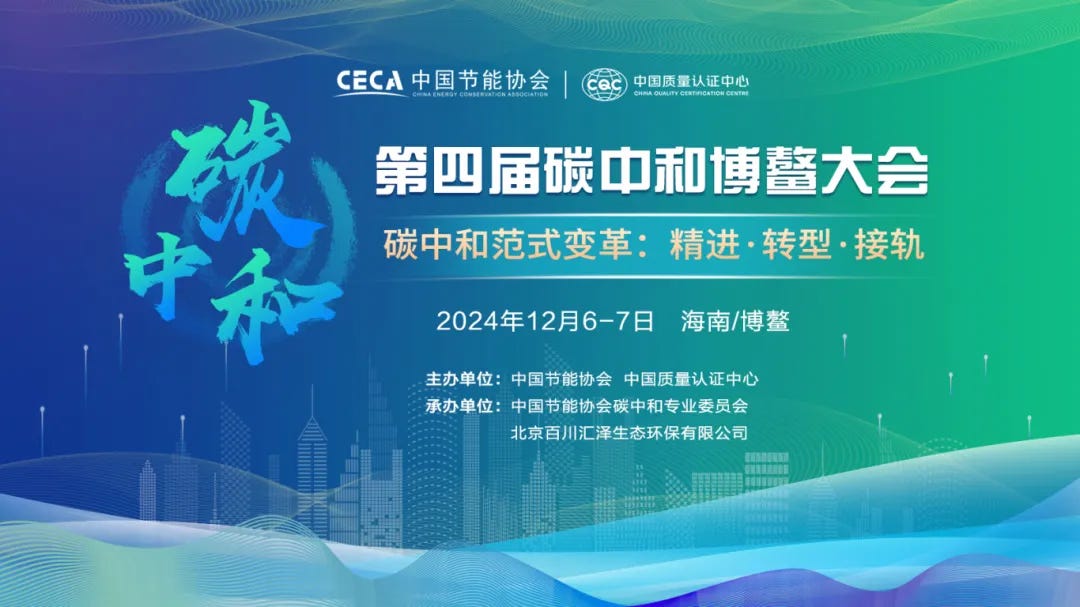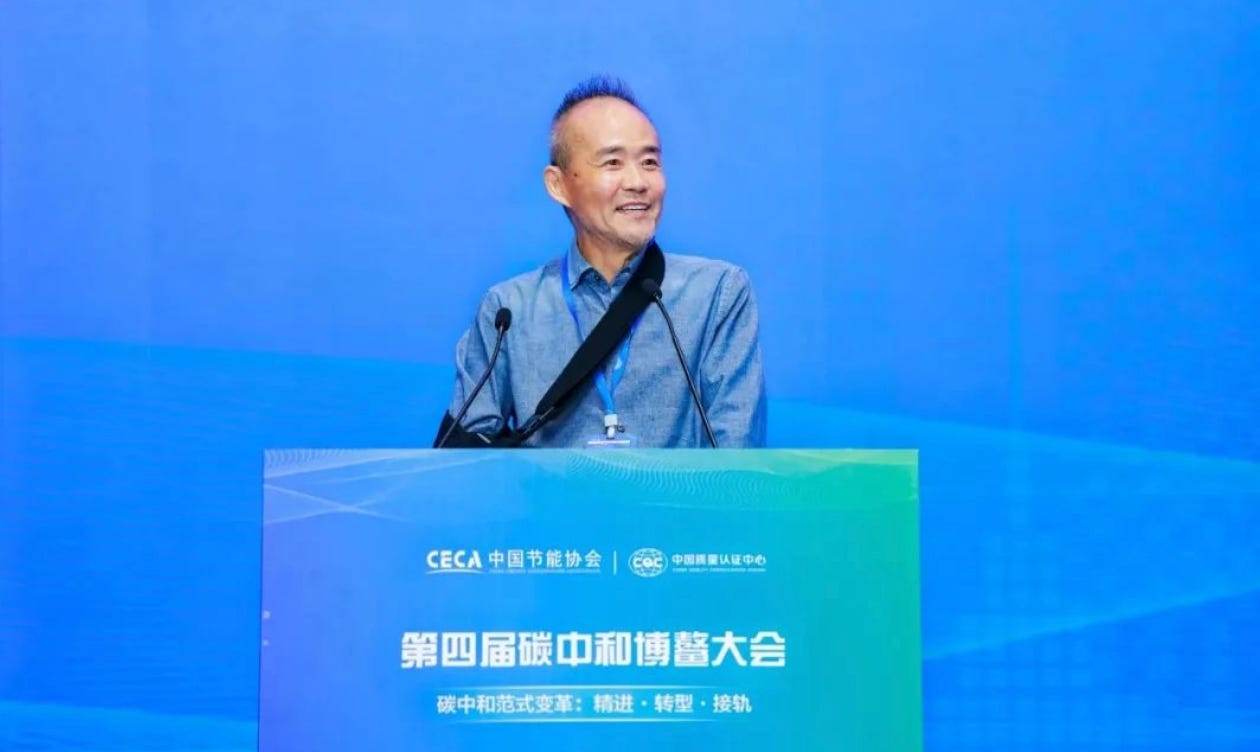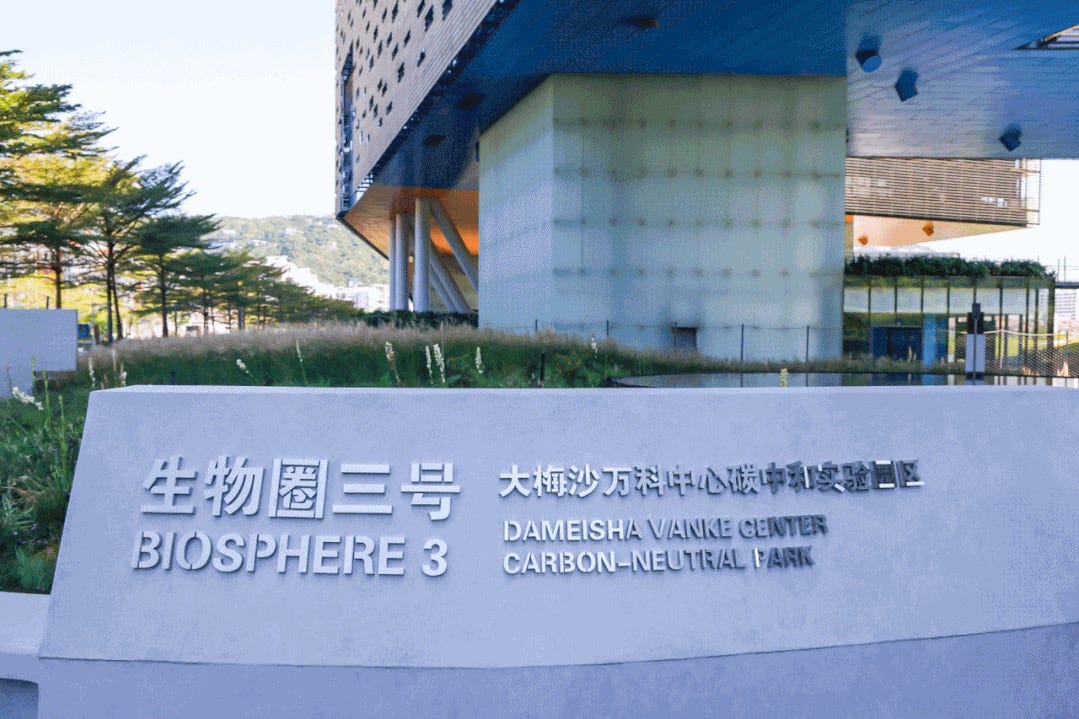China Climate Compass #2: China's top real estate developer on decarbonization
Wang Shi, founder of China Vanke, shares his COP experiences and vision for his "Biosphere 3"
Besides his established capacities in the real estate sector as the Founder and Honorary Chairman of China Vanke Co., Ltd, one of the world’s largest residential home developer, Wang Shi 王石 is also widely known as a visionary trailblazer in China’s environmental initiatives.
As early as 2004, Wang co-founded the Society of Entrepreneurs and Ecology (SEE), China’s first and largest non-governmental environmental network, bringing together hundreds of private sector entrepreneurs across the country. He then was invited to Copenhagen Summit (COP 15) in 2009 as the President of SEE.
There were few Chinese private entrepreneurs so keen on climate issues then, when Paris was even six years away. And ever since 2009, Wang has never missed a COP, all the way to COP 29 in 2024.
One figure may offer you a glimpse of Wang’s dedication to the sustainability initiative: by the time he retired in 2017, 30 percent of China’s highest-grade green buildings were built by Vanke, but that was still only 3 percent of all houses on the market.
Today’s China Climate Compass features a speech by Wang Shi at the 4th Carbon Neutrality Industry Conference in Bo’ao (第四届碳中和博鳌大会), organized by China Energy Conservation Association and China Quality Certification Center, held on December 6-7, 2024.
The conference, themed “Carbon Neutrality Paradigm Transformation: Refinement, Transformation, Alignment” (“碳中和范式变革:精进·转型·接轨”), invited academicians, industry leaders, and corporate representatives from the field of carbon neutrality. It focused on hot topics within the carbon sector, with a particular emphasis on the outcomes of COP29 and related dynamics both in China and beyond.
His speech, titled “From Biosphere 3 to COP29 (从生物圈三号到COP29),” was originally posted on the official Wechat account of Carbon Neutrality Committee of China Energy Conservation Association.
I have to admit that this speech is highly colloquial and omits a substantial amount of background information, which can make it confusing from time to time. I have tried my best to bridge the translation gap, so please bear with me if some of the original meaning is lost.
Below is my translation of the speech.
从生物圈三号到COP29
From Biosphere 3 to COP29
Distinguished guests, good morning. This is the fourth Carbon Neutrality Industry Conference in Bo’ao, and it’s my first time attending. I found it incredibly refreshing and inspiring, especially the keynote speeches. Honestly, what I want to share have been mostly covered by many officials already. As a businessperson rather than a government official, I’d like to share how running a business intersects with carbon neutrality and what I am currently focused on.
I have been attending UN Climate Change Conference since COP15 in 2009, and this year—COP29—marks my sixteenth. Let me explain why Vanke has been committed to green and low-carbon initiatives for so many years. Simply put, we are looking toward the future. Vice Minister Zhao Yingmin mentioned that back then, the EU was investing in tree planting and wind power projects in China. They provided the funding for electricity generation, but the green energy credits were attributed to them. This shows how China’s growth in new energy and the development of protective forests are closely linked to such funding mechanisms. Essentially, it’s a form of compensation: developed countries have the responsibility to assist developing nations in their transition, as stated in the Kyoto Protocol, so they fund the green transformation of developing countries, but the carbon credits from their achievements are counted towards the developed countries’ quotas. You see, these developed countries aren’t providing money without expecting a return.
Ever since COP15, one goal has been clear: developed countries pledged to mobilize USD 100 billion per year in support of climate action in developing countries by 2020. Yet even now, that 100 billion hasn’t been fully met.* Moving from 100 billion to 300 billion doesn’t really change much, because developing countries are asking for 1.3 trillion—there’s a massive gap, which is what all these negotiations and arguments at the UN conference are about. Developed countries have bumped their funding up from 100 billion to 250 billion. In response, developing countries are asking, “Are you serious? We need 1.3 trillion, and you’re offering just 250 billion, and who knows if the money will be truly in place?”
*Note: In fact, the 100-billion target was first met in 2022. Also, at COP29 in 2024, an agreement was reached for developed countries to triple this figure—raising the annual target from 100 billion to 300 billion by 2035.
Let me make this point: for any business to grow, you always need funding. Now, developing countries are needing 1.3 trillion dollars, but developed countries can’t even deliver 100 billion—and now, they are talking about 300 billion.
As an entrepreneur, I want to respond to Trump’s position*. Right after Trump announced the U.S. would withdraw from the Paris Agreement, you saw states like New York and Florida step up, saying, “If the federal government won’t do it, we will.” That’s the first thing. Second, lots of multinational companies are global; they aren’t going to just follow along if the federal government quits. And third, the big NGOs certainly won’t go along with that.
* Note: In 2017, President Donald Trump announced the U.S. would withdraw from the Paris Agreement. However, many U.S. states, corporations, and NGOs continued their own climate initiatives. Later, President Biden rejoined the Agreement in 2021.
Here's my take on the situation: During Trump's first term, China unexpectedly emerged as a climate leader when the U.S. withdrew from international agreements. At UN climate conferences, China essentially became the de facto standard-bearer by default. When the Biden administration sought to reclaim leadership, China pragmatically yielded the spotlight. Now, even if Trump returns to office, he'd hesitate to repeat abrupt withdrawals - knowing full well that another U.S. retreat would force China back into the leadership role whether Beijing wants it or not.
Back in 2021, Carbon Neutrality Committee of China Energy Conservation Association held its very first carbon neutrality conference right here in Bo’ao. Now, the conference is four years old. In my case, I decided to start a new venture in 2021, which lined up perfectly with this Conference. The reason for my new venture all goes back to October 2020, when China announced its twin goals of carbon peak and carbon neutrality at the UN Climate Conference. Right when I heard the news, I said to myself, “I’d be letting myself down big time if I didn’t go for it.”
I just talked about how I led Vanke to be a frontrunner in green and low-carbon development. Vice Mayor Tu Guangshao mentioned ESG, and everybody’s talking about ESG these days—right up to the president of Tsinghua University, who’s also emphasized corporate social responsibility. Actually, this year marks the 20th anniversary of ESG as a concept, and Vanke released its own ESG White Paper 17 years ago. That shows how we’ve been taking on our social responsibility, caring about the larger social and ecological environment, and doing what a company should do. Vanke really has been at the forefront on that.
But after China announced its dual-carbon roadmap, I realized the funding from ESG alone is just a drop in the bucket. We’re entering the carbon economy era, and the entire economic paradigm should be changed. If we want to make things work on a large scale, they have to be commercially viable. That’s why I completely agree with what Vice Mayor Tu said—moving from classical economics to newer economic theories, and then to sustainable development economics. This new paradigm has to stand on its own commercially if it’s going to succeed.
China has done the math: to keep global warming below two °C by the end of this century, China needs to invest 130 trillion yuan (roughly USD 18 trillion). Earlier, I mentioned that the 300 billion and 1.3 trillion —those are in U.S. dollars. At the UN Climate Change Conference, there was a significant disagreement between China’s delegation and the EU—the EU was pushing hard for the 1.5 °C target, while China advocated for 2 °C . But if we really aim for 1.5°C, China’s total investment commitment wouldn’t just double—it’d shoot up to 400 trillion RMB and still might not be enough.
So, transforming our economic model requires massive investments. Whether it's emerging economies or traditional ones, businesses need viable commercial models to make this shift. This is what the carbon-neutral economy and carbon-neutral communities are all about. We’ve branded our initiative as "Biosphere 3." You might be wondering, why "3"? Well, there's Biosphere 1 and Biosphere 2.
Biosphere 1 is our Earth—the only planet we know that supports life and human existence. Biosphere 2 was a large-scale experiment conducted by an American organization in the desert of Arizona, in the 1980s. They built a massive closed laboratory called Biosphere 2, aiming to explore how humans might live outside Earth. They calculated that we would need 2.5 Earths’ worth of energy to support human consumption. This experiment wasn't focused on environmental protection; it was about creating a self-sustaining closed system. Ultimately, the experiment failed.
Biosphere 3, the economic model I’m developing for the carbon-neutral era, focuses on creating carbon-neutral communities—not just achieving zero carbon. While terms like zero carbon, near-zero carbon, and carbon neutrality are often used interchangeably in public discussions, they have distinct meanings academically. What I mean by a carbon-neutral community is managing consumption in such a way that the energy you consume matches the green energy provided to you. However, simply relying on this passive approach isn't enough.
My model revolves around three key principles:
Reduce: The term "reduce" refers to lowering energy consumption by improving energy efficiency, which is exactly what the China Energy Conservation Association focuses on. Reducing carbon emissions doesn’t necessarily mean using less electricity, but rather using it more efficiently. If the goal were simply to cut electricity use, that would be easy—like in southern China during the summer, where the main “culprit” is air conditioning. But simply giving people fans wouldn’t solve the issue. This is what “reducing” really means. For many years, China has excelled at enhancing energy efficiency. Take Singapore or Hong Kong, for instance, where air conditioning is often so cold it could give you a chill. Couldn’t we just raise the temperature by a few degrees? That’s what reduction looks like, and that’s what the China Energy Conservation Association works on.
Substitution: We need to develop solar and wind energy because simply reducing consumption isn’t enough. For example, setting up wind turbines on some open land helps expand our wind energy capacity. When I just came here, a company representative caught up to me and introduced his company specializes in air-source heat pumps. These still fall under the "reduction" category. Now, more rooftops are being equipped with wind turbines and solar panels—that's what we mean by substitution. What I see in cities is that, buildings themselves serve as both consumers and producers of energy. This is an idealistic concept, and it’s unclear whether it’s feasible in the future. Ideally, buildings would completely replace traditional energy with renewable energy, but this is probably not realistic.
Offsetting: This involves quotas, voluntary reductions, carbon assets, carbon credits, and carbon sinks. The "2023-2024 China Carbon Market Industry Development Report" released in the conference is highly insightful and indicative of the future—it’s all about how to offset emissions. In Aug. 2022, I went to Lausanne to visit the headquarters of the Olympic Committee. It is a new building inaugurated in 2020, slightly smaller than Vanke’s headquarters and is touted as a carbon-neutral building. During my visit, I was accompanied by a designer specializing in carbon-neutral designs, and he mentioned that their building generates 15% green electricity. However, I found this surprising because Vanke’s new headquarters, established in 2009, already generated 17.5% of green electricity in 2009. Additionally, Vanke’s headquarters was undergoing renovations in 2022 to increase its green electricity from 17.5% to 85%, while theirs was still only at 15%.
Finally, it became clear why their green electricity generation was relatively low: they can buy carbon allowances to achieve carbon neutrality. On the rooftop, there is a large photovoltaic installation designed as a modern art piece, resembling a blooming flower with solar panels on its petals. While the efficiency of this setup is quite low, it taught me an important lesson: carbon neutrality is not the end goal, but rather a means to improve our quality of life.
Regarding Vanke’s building, I ensure that resources are used wisely without unnecessary waste. The rooftop of our building not only generates electricity but also serves as a venue for international exchanges, not solely focused on carbon emissions.
Mayor Fu Sheng, I have a suggestion. Since Bo’ao has hosted the Carbon Neutrality Industry Conference for four times and has seen many efforts in this regard, such as zero-carbon communities here, I think Bo’ao could consider applying to host the next COP. I’ve attended 16 UN Climate Change Conferences (COPs) myself, and so far, none of them have been held in China. This would be a great opportunity for us to showcase Hainan’s potential, especially considering its development into a future world hub and free trade port. While China has been a major emitter of carbon and some concerns may have arisen in the past, we have never actively applied to host this event. Perhaps now is the time to make this request.
Things are different now. With the new paradigm and new approach, what we’re doing now is a paradigm shift, advancing transformation and aligning with new standards. It’s just a matter of time. Moreover, you are welcome to Biosphere 3 in Yantian District, Shenzhen. Shenzhen is a pioneering city in China’s modern carbon neutrality efforts, and Yantian is a demonstration administrative district. The Biosphere 3 is a pioneering model community in Yantian. To put it simply, this is a 3.2 square kilometer area with a permanent population of 20,000 and a floating population of 20 million. You might wonder why the difference between permanent population and floating population is so large. There’s a Dameisha beach, which is quite different from the beaches in Bo’ao; it’s not like Sanya. In Meisha, there are mountains, the sea, and lakes. By 2028, we plan to reduce carbon emissions by 40% across the entire community, and increase the share of green electricity to 20%. According to the future urban planning for the new district, the Shenzhen government mandates that new districts should account for 5%, while renovation of old districts should reach 20%. As for the demand side, I will bring new opportunities in this paradigm. I have not applied for any national subsidies. If we don’t make progress in carbon neutrality, our business model won’t stand strong.






